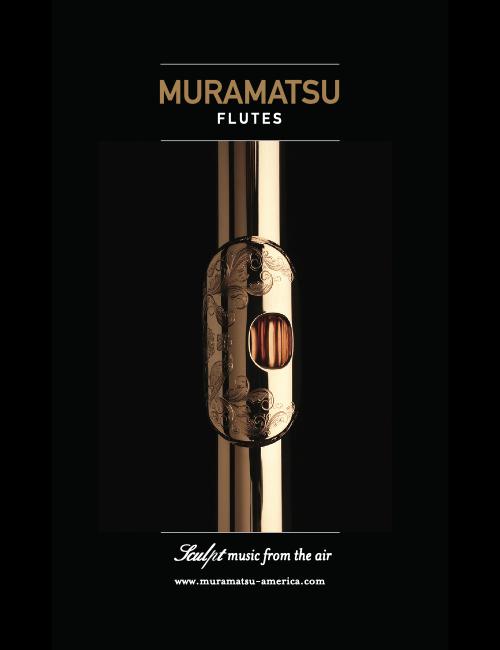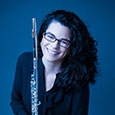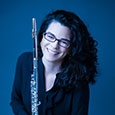Sometimes I wish there was an ideal, methodically structured repertoire guide suitable for every student throughout the duration of their flute study! There are definitely many wonderful repertoire guides and resources which I have studied or learned about recently (included at the end of this article). But – due to the reality that both teachers and students are ever-evolving, individual human beings – finding a one-size-fits-all guide to advancing students through the flute canon may be an impossible task.
In teaching undergraduates at St. Olaf College for the past ten years, I have had the privilege of working with a wide range of flute students – from non-music majors to flute performance majors. These students come to college with equally wide-ranging flute backgrounds and experiences. So, in order to get them started, and progressing, on their college flute journeys, I have found the most success in a flexible and collaborative approach to helping students select repertoire.
“May your choices reflect your hopes, not your fears.”
– Nelson Mandela
At the beginning of each semester, I often require a repertoire list from each student showing exercises, etudes and pieces already studied. Together, we go over the list and begin to identify any major gaps, trying to fill those in first with regard to historical periods (generally starting with the Baroque era and then working through more modern repertoire over the course of study). I have also worked to diversify the repertoire my students learn and encourage them to choose works by underrepresented composers. Additionally, I take the student’s interests into consideration. Is there a piece they really want to play? What aspect of their playing do they need to improve at this time? I ask many questions and listen intently. As they begin to open up, I start brainstorming ideas with them – using my own music collection, repertoire lists from my previous teachers and other flutists I admire, as well as some of the new repertoire guides, I mentioned previously. I often display several scores, play samples of pieces, and, together, the student and I choose 3-4 works from several repertoire options presented. I have found that when a student is at least partly invested in their repertoire choice, they are more likely to complete it in a satisfactory way. By the end of our meeting, we have a basis for our semester plan of flute-specific goals, improvements wanting to be made, exercises geared to making those improvements, etudes, and repertoire options. This plan can be adjusted as the semester progresses.
A student may want to learn a piece that will challenge them in a new way. If I feel this is a doable stretch, I encourage it. If it is a piece that may be beyond their current abilities, I caution them, but, if they insist, will sometimes let them work on it anyway. In those cases, a student may rise to the challenge and surprise not only me, but themselves, with what they are able to accomplish. However, a student may just as likely get to a point where they discover that certain passages are beyond their abilities at this time. It is a valuable experience for a student to learn what their current limitations are. I would rather have a student tackle such a difficulty and learn this lesson, rather than be discouraged from taking that chance and never know what that outer limit might presently be.
“It is our choices, Harry, that show what we truly are, far more than our abilities.”
– J.K. Rowling, Harry Potter and the Chamber of Secrets
The music we choose to play becomes part of us in a way that reflects who we are, how we feel, and where we hope to go. Tone and technical studies lay a knowing foundation deep within our bodies. Etudes corral our air and energy. Repertoire and excerpts immerse us in perspectives of life experience from across time and place. As creative people, it is important for flute teachers to use our imaginations to solve problems and find innovative solutions, including how we help our students choose repertoire.
Below is a sample of the music I have used with students over the years:
Technical And Tone Development Studies
First Year
Moyse De La Sonorité
Bernold La Technique d’Embouchure
P. George/P.A. Louke The Flute Scale Book
Nina Assimakopulous The Virtuosic Flutist
Taffanel & Gaubert Daily Exercises
Trevor Wye Tone and Technique Books
Second Year
Moyse De La Sonorité
Bernold La Technique d’Embouchure
Robert Dick Tone Dev. Extended Techniques
P. George/P.A. Louke The Flute Scale Book
Nina Assimakopulous The Virtuosic Flutist
Taffanel & Gaubert Daily Exercises
Trevor Wye Tone and Technique Books
Reichert Daily Studies
Maquarre Daily Studies
J. Baker Scale Studies
P.L. Graf Check-Up
Third Year
Moyse De La Sonorité; Gammes et Arpèges
Moyse How I Stayed in Shape
Moyse Tone Dev. Through Interpretation
Mazzanti Method for Piccolo (also on flute)
Robert Dick Tone Dev. Extended Techniques
Paul Edmund-Davies 28 Day Warm-Up
Taffanel & Gaubert Daily Exercises
Reichert Daily Studies
P. George/P.A. Louke The Flute Scale Book
Gilbert Technical Flexibility
P.L. Graf Check-Up
Fourth Year
Moyse De La Sonorité; Gammes et Arpèges
Moyse How I Stayed in Shape
Moyse Tone Dev. Through Interpretation
Bernold La Technique d’Embouchure
Mazzanti Method for Piccolo (also on flute)
Robert Dick Tone Dev. Extended Techniques
Paul Edmund-Davies 28 Day Warm-Up
Taffanel & Gaubert Daily Exercises
Reichert Daily Studies
P. George/P.A. Louke The Flute Scale Book
Gilbert Technical Flexibility
P.L. Graf Check-Up
Etudes
First Year
Anderson Etudes, op. 33
Gariboldi Etudes
Hugues Studies
Selected Studies (Rubank)
Melodious and Progressive Studies, Bk 1
Mary Karen Clardy Flute Etudes Book
Second Year
Anderson Etudes, op. 33, 21, 37, 30, 63, 41
Selected Studies (Rubank)
Melodious & Progressive Studies, Bk 2, 3
Karg-Elert Etude Books 2 and 3
The Modern Flutist (Southern Music)
Third Year
Anderson Etudes, op. 21, 30, 33, 37, 41, 15
Altes 26 Selected Studies
Furstenau 26 Studies
JeanJean Etudes
Damase Etudes
P.L. Graf Study with Style (30 Etudes)
Paganini Caprices
Fourth Year
Anderson Etudes, op. 15
Altes 26 Selected Studies
Bozza 14 Arabesques
Casterede Douze Etudes
JeanJean Etudes
Damase Etudes
Paganini Caprices
Repertoire
First Year
Handel Sonatas
J. S. Bach Sonatas in C and E
Telemann 12 Fantasias
Marin Marais Les Folies d’Espagne
Flute Music of the Baroque (ed. Louis Moyse)
Flute Music By French Composers (Schirmer)
A Touch of Blue (arr. Paula Robison)
24 Short Concert Pieces (Cavally)
Bloch Suite Modale
Burton Sonatina
Copland Duo
Hindemith Sonata
A. Lauro El Marabino and Carora
Mercadante Concerto in E Minor
Morlacchi The Swiss Shepherd
Mozart D & G Major Concertos
Muczynski Three Preludes
Saint-Saens Romance
Schumann Romances
Stamitz Concerto in G
Vivaldi Concerti (flute)
Second Year
Handel Sonatas
J.S. Bach Sonatas, Solo Partita in A minor
C.P.E. Bach Sonatas
Anna Bon di Venezia Sonata
Burton Sonatina
Caplet Reverie & Petite Valse
Copland Duo
Debussy Syrinx
Devienne Sonatas, Concerto in E Minor
Donizetti Sonata in C Major
Doppler Hungarian Pastorale Fantasy
Faure Flute Album
Flute Music By French Composers (Schirmer)
Gaubert Madrigal, Romance
Godard Suite, op. 116
Gordeli Concerto
Griffes Poem
Hindemith Sonata
Honegger Danse de la Chèvre
Hoover To Greet the Sun, Kokopeli
A. Lauro Vals Venezolanos
A. Loggins-Hull Homeland
Mercadante Concerto in E Minor
Mozart Andante and Rondo
Mozart D & G Major Concertos
Muczynski Sonata
Poulenc Sonata
Quantz Concertos
F. Price Adoration, Deserted Garden
Reinecke “Undine” Sonata
Rivier Oiseaux Tendres
Sancan Sonatine
Varese Density 21.5
Vivaldi Concerti (piccolo)
Third Year
J.S. Bach Sonatas, Solo Partita in A minor
C.P.E. Bach, Solo Sonata, Concerto, Hamburg Sonata
Bartok Suite Paysanne Hongroise
Beach Romance
Bozza Image
Clarke Zoom Tube
Dorff Flash (piccolo)
Dutilleux Sonatine
Ferroud Trois Pieces
Flute Music by French Composers (Schirmer)
Gaubert Sonatas
Great Concert Encores for Flute (Schirmer)
Hindemith Acht Stucke (Eight Pieces)
Ibert Piece
A. Hailstork Yuhwa
U. Kay Prelude
La Montaine Sonata
Mozart D & G Major Concertos
Muczynski Sonata
Prokofiev Sonata
Reinecke Ballade
Schumann Three Romances
Schubert Arpeggione
Takemitsu Air
Taktakishvili Sonata
Telemann 12 Fantasias
Varese Density 21.5
Vivaldi Concerti (piccolo)
Widor Suite, op. 34
Fourth Year
J.S. Bach Sonatas, Solo Partita in A minor
C.P.E. Bach Concerto in D minor
V. Coleman Danza de la Mariposa
Damaré La Tourterelle (piccolo)
Demersseman Sixth Solo de Concert "Italian"
Feld Sonatine
Flute Music By French Composers (Schirmer)
Franck Sonata
Fukushima Mei
Gordeli Concerto
Granados Hibiee-Jibiees
A. Hailstork Flute Set
Hanson Serenade
Ibert Concerto
Jolivet Chant de Linos, Concerto
Karg-Elert Sonata in F# Minor, Op. 140
Larson Be Still My Soul
Liebermann Concerto; Sonata for Flute, Piccolo Concerto
Martin Ballade
Martinu First Sonata
McKimm Piccolo Concerto (piccolo)
Mozart D & G Major Concertos
Nielsen Concerto
Prokofiev Sonata
Reinecke Concerto
Rouse Concerto
Schubert Variations on Trockne Blumen
Takemitsu Voice for Solo Flute
Vaughan Williams Lark Ascending
Widor Suite, op. 34
Chen Yi Memory for Solo Flute
Excerpts
From Jeanne Baxtresser’s Orchestral Excerpts Book, Vol. 1
First Year
Bach Badinerie, Beethoven Eroica, Bizet Carmen, Brahms 1, Debussy Faune, Gluck, Mendelssohn
Second Year
Bach Polonaise, Beethoven L.2, Brahms 4, Dvorak, Hindemith Sym, Peter 1, Ravel Bolero, Ravel Daphnis, Strauss Till, Tchaikovsky 4.1
Third Year
Bach Aus Liebe, Beethoven L.1, Debussy, Mahler Das Lied, Mendelssohn, Ravel Daphnis, Peter 2+3, Prokofiev Classical, Stravinsky Petrouchka, Tchaik 4.2
Fourth Year
Prokofiev Classical, Ravel Daphnis, Rossini Carnival, Rimsky-Korsakov Russian Easter, Strauss Salome, Stravinsky Firebird
So, in addition to the flexible and collaborative approach I described above, and the repertoire resources I have listed below, I would like to leave you with one more rather unconventional method that I sometimes use to choose repertoire for myself, in the hope that it might encourage you and your students to be creative and innovative. I have always loved paper. I believe that the smell of a book can tell you a little something about what is inside. I also believe that what a score looks like and how the music notation appeals to the eyes, say something too. If I come across some flute music that I don’t know anything about besides what I’m holding in my hands – what I’m seeing on the page, how the white space interacts with the ascending and descending shapes of ink on the page – before I even try to sing any of it in my mind – I begin to get a sense of whether or not I might like to play this piece. I may think about the concert program I’m preparing for, the time I have to dedicate to learning it, and whether or not I would need to find other musicians to bring the piece to life. All these things have gone through my mind while I start to leaf through the music. As we continue this year in a pandemic-era world, here’s my unconventional advice: after you put your mask on and wash your hands, spend some time in the music library stacks or a music store perusing the flute scores, and allow your senses to direct your next repertoire choice.

Additional Repertoire Resources
“Teaching a Diverse Repertoire” Chart by Leonard Garrison and Paul Taub
https://docs.google.com/document/d/1XjmO1VnpKncwYAsXle_yz5EMJWd563c20zisaX7nuOE/edit
Music By Black Composers
https://docs.google.com/document/d/1BuAGeLrTHf0X-3HIM8IGzK7P41vKYoPt6CPclZGVSYU/edit
Women Composers by Time Period
https://www.oxfordmusiconline.com/page/women-composers-by-time-period
Latin and South American Flute Music by Cayambis Music Press
https://www.cayambismusicpress.com/unaccompanied-flute-and-piccolo-s/1986.htm?searching=Y&sort=7&cat=1986&show=10&page=2
Music by Underrepresented Composers
https://americanorchestras.org/learning-leadership-development/diversity-resource-center/resources-for-diversity-in-repertoire.html
Composers Equity Project
https://www.chamber-music.org/pdf/2019-CCP/Composers-Equity-Project.pdf
Institute for Composer Diversity
https://www.composerdiversity.com/?fbclid=IwAR0GbXwreGfRZwo2JheCXlD7I9ogRP1dwMzBhRF2LQjTK9qnAucHt7m925c
Music by BIMOC (Black Indigenous Musicians of Color) crowdsourced list of works
https://www.gabrieladiazviolin.com/bimoc
African Diaspora Music Project (art song)
https://africandiasporamusicproject.org/
National Flute Association (NFA) Selected Flute Repertoire and Studies: A Graded Guide
https://www.nfaonline.org/docs/default-source/committees-documents/pedagogy-committee/selected-flute-repertoire-and-studies.pdf?sfvrsn=4099aec6_2
Royal Conservatory Graded Repertoire and Studies List
https://files.rcmusic.com//sites/default/files/files/S32_FluteSyllabus_2016_online_SECURED.pdf (grade 6 and up)
ABRSM – Associated Board of the Royal Schools of Music Flute Syllabus (Level 1-8)
https://us.abrsm.org/media/62985/flute_-_all_grades.pdf (grade 6 and up)
(Level 9 and Advanced) (pp.58-60)
https://us.abrsm.org/media/62444/diploma-performance-syllabus-2019-web.pdf
University of West London Repertoire List
http://www.esamilcm.it/wp-content/uploads/2018/02/flute-repertoire-list.pdf
Leonard Garrison’s Graded Repertoire List
http://www.leonardgarrison.com/applied-repertoire/
Jennifer Cluff’s Website: Lists of Repertoire for High School Level Flutists
https://www.jennifercluff.com/replists.htm#quest
Jennifer Cluff’s Website: Lists for University Level Flutists
https://www.jennifercluff.com/replists.htm#proffess
Links to Many Other Repertoire Lists
https://www.jennifercluff.com/replists.htm







